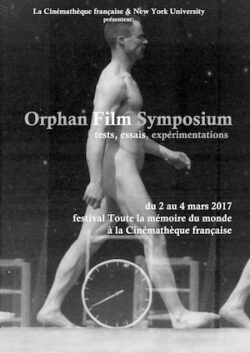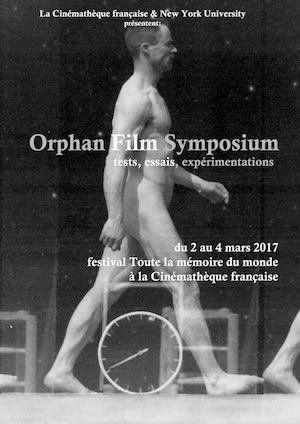The Orphan Film Symposium is usually held every two years in the United States. This year a more compact Orphans was organized in the city of Paris with the Cinémathèque Française. This is the second time that NYU has partnered with a European film institution to organize this event.
This year’s theme was Tests, essais et expérimentations. The symposium was organised at the same time as Toute la Mémoire du monde, Cinémathèque Française’s restauration film festival. Orphans was scheduled from Thursday March 1st to Saturday March 4th and sessions were held in the morning, allowing the attendees to also catch a few films at the festival or talks held simultaneously on various subjects.
This is the second time I have attended an Orphan Film Symposium, the first time was in Amsterdam where the programme ran all day making it one of the most intense conferences I had ever attended. The beauty of Orphans is that it is screening-heavy, by which I mean that the majority of time is dedicated to actually showing rare footage or which escapes definition and cataloguing standards.
The programme was a varied mix of newsreel, film outtakes, experimental films and home movies. Not every project can be labelled orphan or fits the symposium perfectly, however, since the audience gets to see a lot it does not really matter.
I am just going to briefly focus on the home movies, since those are of particular interest to the INEDITS members. The home movies shown could not have been more different in nature.
Kay Gladstone from the Imperial War Museum (IWM) gave a heart-warming presentation entitled: “Clandestinity: Amateur Films of Secret Subjects in France and Belgium during the Second World War”, in which he explains how these films from two different families, one French, one Belgian, got into the IWM’s archives and also what had happened to these families during and after the war. The French family films were particularly striking as they showed classical amateur footage of family life. Unfortunately these joyous images of people smiling at and posing in front of the camera are followed by images recorded by the family patriarch in the internment camp Beaune-la-Rolande, located in the outskirts of Paris. In fact, the family was sent to Nazi-transit camps before being transported to extermination camps. The footage which has survived provides a very rare glimpse into this part of French history. The lower angles and shots through doors and windows clearly indicate the secrecy of the recorded material. These images were donated to and are preserved by the Imperial War Museum in London.
Rachel Stoeltje from the Indiana University Libraries showed us John Ford’s personal home movies shot during one of his many Mexico trips with his pals Henry Fonda, who is often seen sleeping during the trip, and John Wayne. These testosterone fuelled drinking, smoking and fishing trips are beautifully documented in colour and preserved by the University. These images might be familiar to some; however, as they have great market value the family aims to restrict access to them, as such it was a rare treat to seem them project onto a big screen.
These two examples show the large potential of home movies, and the many different audiences and researchers they can address. Seeing home movies within the context of Orphans also provides for new thoughts on contextualisation and definition, as these films are juxtaposed to experimental films, films maudits, and other not easily categorized moving images.
You can find the entire program here. The next Orphan Film Symposium on the theme of LOVE will take place in New York City in partnership with the Museum of Moving Image.
Alessandra Luciano
National Audiovisual Center (Luxembourg)


